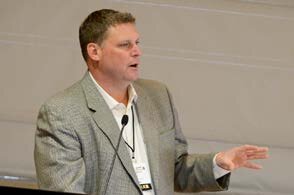Join us to hear Indiana’s own Christopher Tull, PE of CRT Consulting discuss ACI 302.
Description:
The quality of a concrete floor or slab is highly dependent on achieving a hard and durable surface that is flat, relatively free of cracks, and at the proper grade and elevation. Properties of the surface are determined by the mixture proportions and the quality of the concreting and jointing operations. The timing of concreting operations—especially finishing, jointing, and curing—is critical. Failure to address this issue can contribute to undesirable characteristics in the wearing surface such as cracking, low resistance to wear, dusting, scaling, high or low spots, poor drainage, and increasing the potential for curling.
Concrete floor slabs employing portland cement, regardless of slump, will start to experience a reduction in volume as soon as they are placed. This phenomenon will continue as long as any water, heat, or both, is being released to the surroundings. Moreover, because the drying and cooling rates at the top and bottom of the slab are not the same, the shrinkage will vary throughout the depth, causing the as-cast shape to be distorted and reduced in volume.
This guide contains recommendations for controlling random cracking and edge curling caused by the concrete’s normal volume change. Application of present technology permits only a reduction in cracking and curling, not elimination. Even with the best floor designs and proper construction, it is unrealistic to expect completely crack- and curl-free floors. Consequently, every owner should be advised by both the designer and contractor that it is completely normal to expect some amount of cracking and curling on every project, and that such an occurrence does not necessarily reflect adversely on either the adequacy of the floor’s design or the quality of its construction (Ytterberg 1987).
This guide describes how to produce high-quality concrete slabs-on-ground and suspended floors for various classes of service. It emphasizes such aspects of construction as site preparation, concrete materials, concrete mixture proportions, concrete workmanship, joint construction, load transfer across joints, form stripping procedures, finishing methods, and curing. Flatness/levelness requirements and measurements are outlined. A thorough preconstruction meeting is critical to facilitate communication among key participants and to clearly establish expectations and procedures that will be employed during construction to achieve the floor qualities required by the project specifications. Adequate supervision and inspection are required for job operations, particularly those of finishing.
Chris Tull
Licenses
Professional Engineer OH, IN, KY, MI LEED AP ®
ACI Level 1 Certified
ICRI Moisture Testing Certified
Experience
30 years of experience in the material, engineering and placement facets of concrete construction. Has considerable knowledge of the industry from working for a large concrete contractor, a construction manager, the Indiana Ready Mix Concrete Association and a ready mix producer.
As Vice President of Production and Quality for a large ready mix concrete company, developed efficient and high quality ready mix operations. Have experience with concrete mix designs, concrete slab-on-grade technologies as well as slip-form concrete pavements.
CRT Concrete Consulting, LLC was founded in February of 2007 and focuses on a relationship- based approach to technical issues. Specialties include items such as:
Developing low shrinkage slab-on-grade mixtures
Planning and integrating finished and polished concrete decorative floors
Slab and pavement design and optimization
Trouble shooting concrete in the field
Creating and implementing concrete related training
Educating engineers and contractors on state-of-the-art design criteria
Generating roller compacted concrete in ready mix facilities
Solutions to concrete slab moisture related issues and testing
Mass concrete thermal plans and temperature control systems
Honors and Affiliations
American Society of Concrete Contractors
American Concrete Institute. Voting member of the following committees:
o 302: Construction of Concrete Floors
310: Decorative Concrete
327: Roller Compacted Concrete
360: Design of Slabs on Ground
American Society of Testing Materials
Member of International Concrete Repair Institute
330: Concrete Parking Lots and Site Paving (Chairman)
332: Residential Concrete Work
Past President of the Indiana Chapter of the American Concrete Association
World of Concrete Speaker
Education
achelor of Science in Civil Engineer g
Cornell University; Ithaca, New York
